Jurnal
Achieving Gender Equality Requires Placing Adolescents at the Center
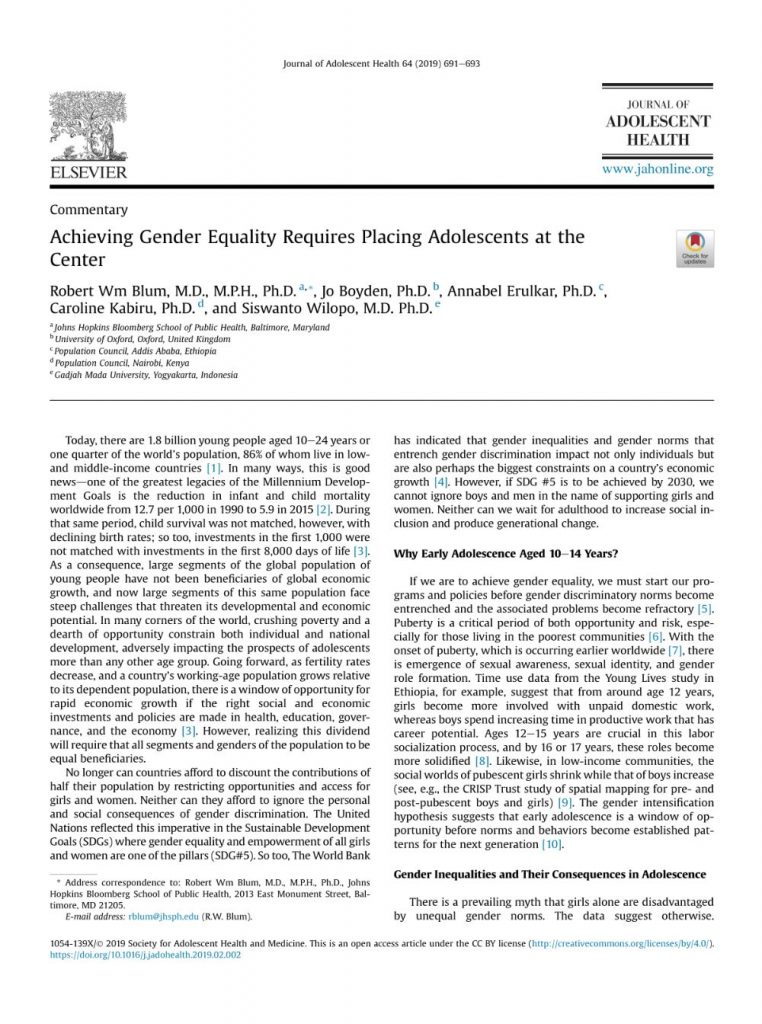
Robert Wm Blum, Jo Boyden, Annabel Erulkar, Caroline Kabiru, Siswanto Agus Wilopo
Achieving Gender Equality Requires Placing Adolescents at the Center
- JURNAL
Today, there are 1.8 billion young people aged 10e24 years or one quarter of the world’s population, 86% of whom live in lowand middle-income countries [1]. In many ways, this is good newsdone of the greatest legacies of the Millennium Development Goals is the reduction in infant and child mortality worldwide from 12.7 per 1,000 in 1990 to 5.9 in 2015 [2]. During that same period, child survival was not matched, however, with declining birth rates; so too, investments in the first 1,000 were not matched with investments in the first 8,000 days of life [3]. As a consequence, large segments of the global population of young people have not been beneficiaries of global economic growth, and now large segments of this same population face steep challenges that threaten its developmental and economic potential. In many corners of the world, crushing poverty and a dearth of opportunity constrain both individual and national development, adversely impacting the prospects of adolescents more than any other age group. Going forward, as fertility rates decrease, and a country’s working-age population grows relative to its dependent population, there is a window of opportunity for rapid economic growth if the right social and economic investments and policies are made in health, education, governance, and the economy [3]. However, realizing this dividend will require that all segments and genders of the population to be equal beneficiaries.
Achieving Gender Equality Requires Placing Adolescents at the Center Read More »
Measuring agency as a dimension of empowerment among young adolescents globally; findings from the Global Early Adolescent Study
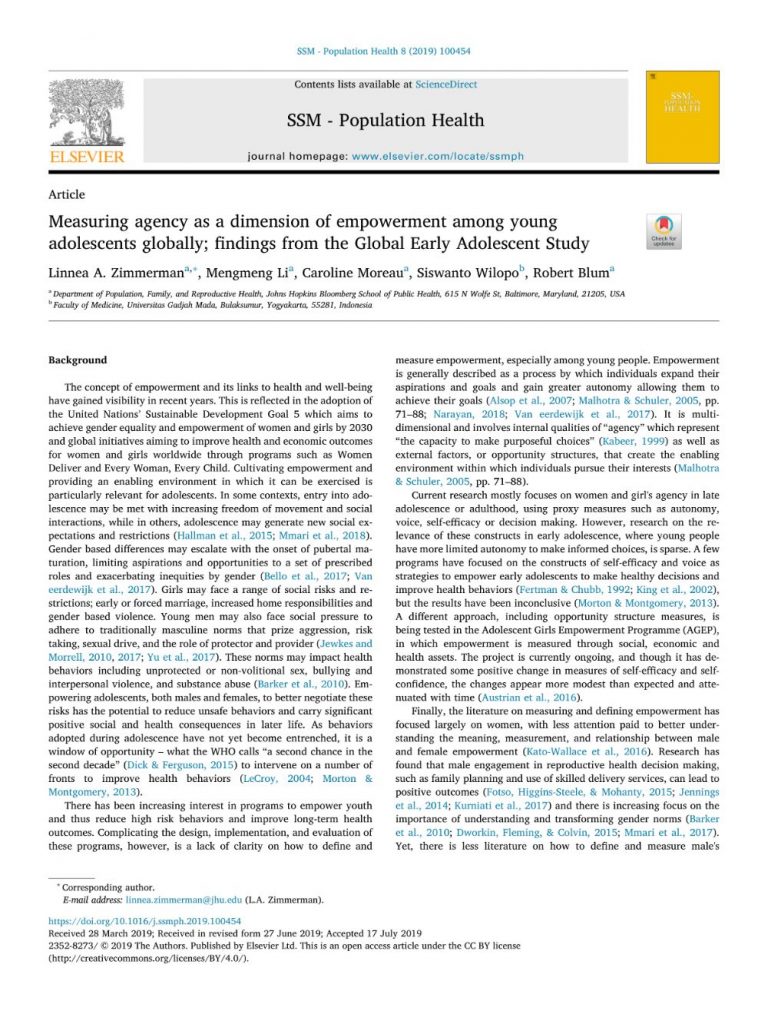
Linnea A Zimmerman, Mengmeng Li, Caroline Moreau, Siswanto Agus Wilopo, Robert Blum
Measuring agency as a dimension of empowerment among young adolescents globally; findings from the Global Early Adolescent Study
- JURNAL
The concept of empowerment and its links to health and well-being have gained visibility in recent years. This is reflected in the adoption of the United Nations’ Sustainable Development Goal 5 which aims to achieve gender equality and empowerment of women and girls by 2030 and global initiatives aiming to improve health and economic outcomes for women and girls worldwide through programs such as Women Deliver and Every Woman, Every Child. Cultivating empowerment and providing an enabling environment in which it can be exercised is particularly relevant for adolescents. In some contexts, entry into adolescence may be met with increasing freedom of movement and social interactions, while in others, adolescence may generate new social expectations and restrictions (Hallman et al., 2015; Mmari et al., 2018).
The role of decision-making pattern on the use of long-acting and permanent contraceptive methods among married women in Indonesia

I Gusti Agung Agus Mahendra, Siswanto Agus Wilopo, Sukamdi, I Gusti Ngurah Edi Putra
The role of decision-making pattern on the use of long-acting and permanent contraceptive methods among married women in Indonesia
- JURNAL
Objectives:
This study aimed to analyse the association between the decision-making pattern and the use of long-acting and permanent methods of contraception (LAPMs) among married and cohabiting women in Indonesia, by controlling for variables at the individual and community or regional level, and geographical area (province).
Methods:
A cross-sectional survey was conducted using secondary data from Performance Monitoring and Accountability 2020 (PMA2020) which involved 4724 married or cohabitating women aged 15–49 years. Data were analysed using bivariate and multivariate analysis. Multilevel logistic regression was performed to investigate the determinants by taking geographical area into account.
Results:
The majority of women (63.8%) had made their own decision on current contraceptive use, 30.1% had made a joint decision with their partner or health care provider, and 6.1% had not been involved in the decision-making process. Multilevel analysis showed that the decision-making pattern and individual level factors were significantly associated with LAPM use, and variables at community or regional level were not significant predictors. Compared with women who had made their own decision on contraceptive use, LAPM use was 2.3 times higher in women who had made a joint decision with their partner or health care provider (odds ratio [OR] 2.3; 95% confidence interval [CI] 2.0, 2.7; p < .001) and more than three times higher in women not involved in the decision-making process (OR 3.1; 95% CI 2.3, 4.1; p < .001).
Conclusion:
Coercion potentially occurs in the contraceptive decision-making process. Our findings suggest that LAPM use may be increased by encouraging joint contraceptive decision making. Increasing women’s participation in the decision-making process is an integral part of respecting women’s reproductive autonomy.
Facilitators and barriers for the delivery and uptake of cervical cancer screening in Indonesia: a scoping review
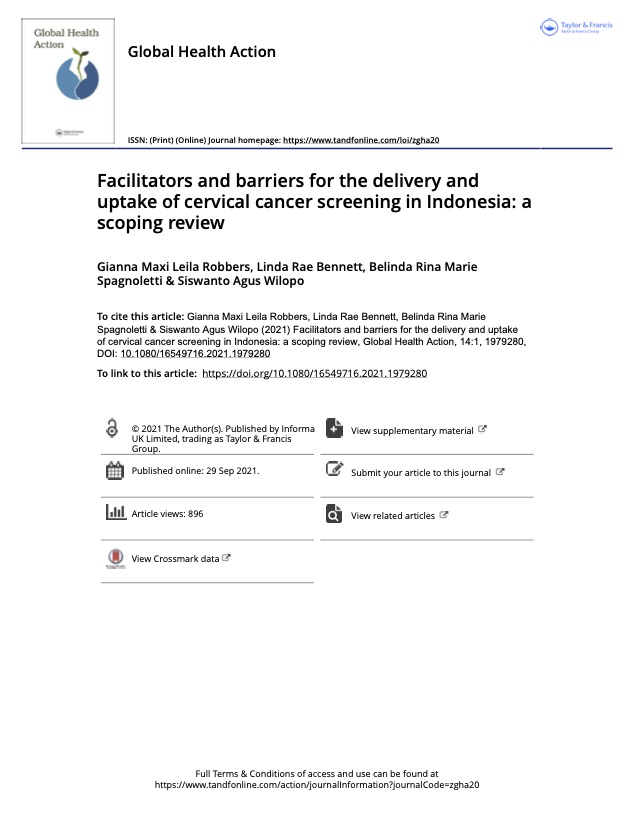
Gianna Maxi Leila Robbers, Linda Rae Bennett, Belinda Rina Marie Spagnoletti & Siswanto Agus Wilopo
Facilitators and barriers for the delivery and uptake of cervical cancer screening in Indonesia: a scoping review
- JURNAL
Background: Cervical cancer (CC) is the second most common female cancer. In Indonesia, national CC screening coverage is low at 12%, highlighting the need to investigate facilitators and barriers to screening. Objective: This review synthesises research on facilitators and barriers to the delivery and uptake of CC screening; analyses them in terms of supply- and demand-side factors and their interconnectedness; and proposes recommendations for further research. Methods: Medline Ovid, CINAHL, Global Health, Neliti, SINTA and Google Scholar were searched, applying a search string with keywords relevant to screening, CC and Indonesia. In total 34 records were included, all were publications on CC screening in Indonesia (2000- 2020) in English or Indonesian. Records were analysed to identify findings relevant to the categories of barriers and facilitators, supply-and demand-side factors. Results: Demand-side facilitators identified included: husband, family or social/peer support (14 studies); information availability, knowledge and awareness (12 studies); positive attitudes and strong perception of screening benefit and the seriousness of CC (12 studies); higher education and socioeconomic status (11 studies); having health insurance; and short distance to screening services (4 studies). Evidence on supply-side was limited. Supply-side facilitators included counselling and support (6 studies), and ease of access (6 studies). Demand-side barriers identified focused on: lack of knowledge/awareness and lack of confidence in screening (14 studies); fear, fatalism and shame (10 studies); time and transportation constraints (8 studies); and lack of husband approval and support (6 studies). Supply-side barriers included: lack of skilled screening providers (3 studies); lack of advocacy and health promotion (3 studies); resource constraints (3 studies); and lack of supervision and support for health care providers (3 studies). Conclusions: Facilitators and barriers were mirrored in the supply- and demand-side findings. The geographical scope and population diversity of existing research is limited and further supply-side research is urgently needed.
The Primary Health Center Factors Associated with Contraceptive Use Among Women in Indonesia
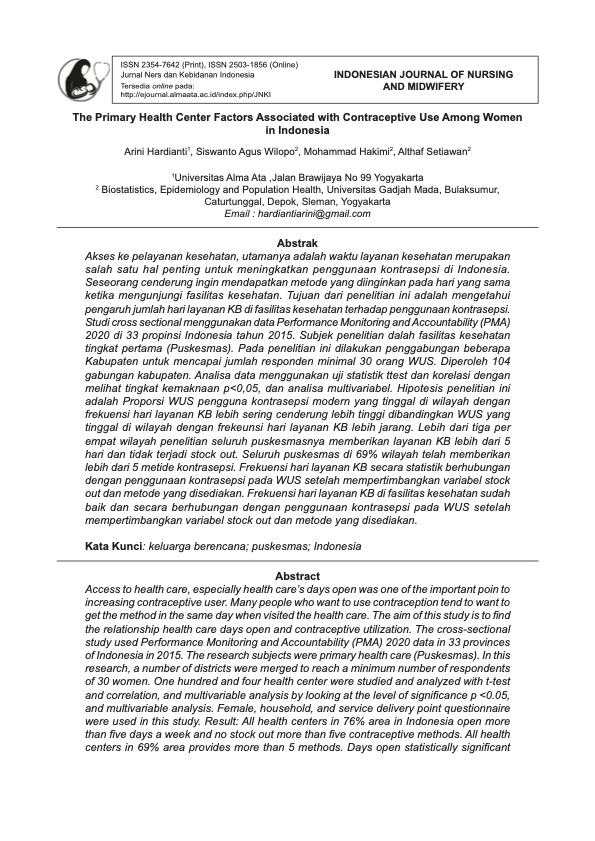
Arini Hardianti, Siswanto Agus Wilopo, Mohammad Hakimi, Althaf Setiawan
The Primary Health Center Factors Associated with Contraceptive Use Among Women in Indonesia
- JURNAL
Access to health care, especially health care’s days open was one of the important poin to increasing contraceptive user. Many people who want to use contraception tend to want to get the method in the same day when visited the health care. The aim of this study is to find the relationship health care days open and contraceptive utilization. The cross-sectional study used Performance Monitoring and Accountability (PMA) 2020 data in 33 provinces of Indonesia in 2015. The research subjects were primary health care (Puskesmas). In this research, a number of districts were merged to reach a minimum number of respondents of 30 women. One hundred and four health center were studied and analyzed with t-test and correlation, and multivariable analysis by looking at the level of significance p <0.05, and multivariable analysis. Female, household, and service delivery point questionnaire were used in this study. Result: All health centers in 76% area in Indonesia open more than five days a week and no stock out more than five contraceptive methods. All health centers in 69% area provides more than 5 methods. Days open statistically significant with modern contraceptive utilization after considering the stock out and method provides. Conclusion: contraceptive days open in health care generally good and have relation with contraceptive utilization after considers the stock and how many methods they provide.
Declining age at menarche in Indonesia: a systematic review and meta-analysis

Abdul Wahab, Siswanto Agus Wilopo, Mohammad Hakimi, Djauhar Ismail
Declining age at menarche in Indonesia: a systematic review and meta-analysis
- JURNAL
Background: There has been much research on the average age at menarche onset. In higher income countries the lowering in average age at menarche is earlier than in middle-income countries and lower income countries. Indonesia as a middle-income country also has some research experience related to the average age at menarche for girls. Objectives: This study aimed to review the lowering of the average age at menarche in Indonesia and to predict changes in average age at menarche. Methods: This study provides a systematic review and meta-analysis using references from Google Scholar, PubMed and Popline databases on the trend of age at menarche in Indonesia and other data sources from local and national survey reports. Metaprop command in STATA was used to do the meta-analysis of proportion of early age at menarche and time series with auto-regressive integrated moving average (ARIMA) models were used in analyzing the trend and predicting the age at menarche. Results: The results show that in Indonesia the timing of age at menarche onset has significantly lowered during the 40 years before 2010. There was meaningful decrease of age at menarche, which changed from 14.43 years [confident interval (CI) 95%: 14.42, 14.44] to 13.63 years (CI95%: 13.63, 13.64). Using the ARIMA model, mean age at menarche onset for the next year predicted that the coefficient regression would be −0.0245 (CI95%: −0.0275, −0.0215). The predicted average age at menarche shows a decrease of 0.0245 years (8–9 days) each year. Conclusion: The findings indicate a significant lowering of age at menarche in Indonesian girls that has continued as a predictable trend through time until the present, paralleling recent socioeconomic changes. These predictions provide key indicators of a girl’s future healthy transition from childhood into young adulthood.
Declining age at menarche in Indonesia: a systematic review and meta-analysis Read More »
Levels, trends and correlates of unmet need for family planning among postpartum women in Indonesia: 2007–2015
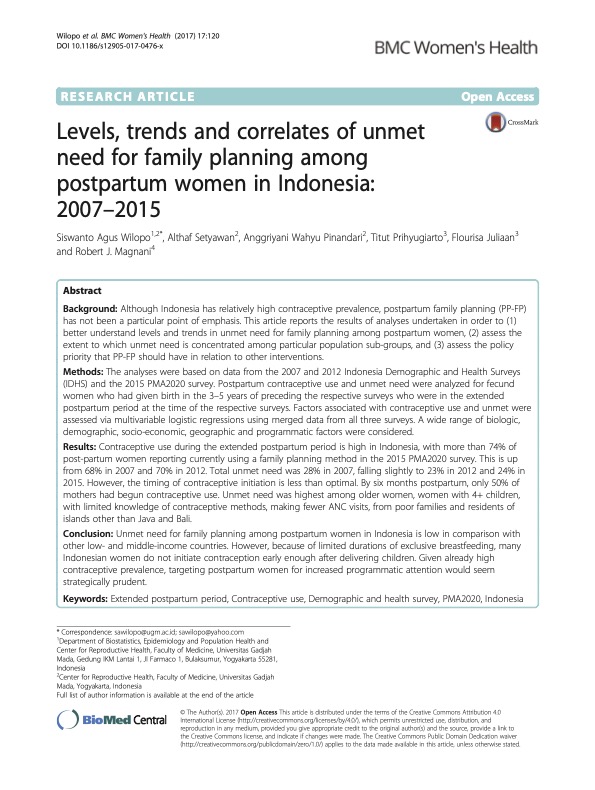
Siswanto Agus Wilopo, Althaf Setyawan, Anggriyani Wahyu Pinandari, Titut Prihyugiarto, Flourisa Juliaan, Robert J Magnani
Levels, trends and correlates of unmet need for family planning among postpartum women in Indonesia: 2007–2015
- JURNAL
Background
Although Indonesia has relatively high contraceptive prevalence, postpartum family planning (PP-FP) has not been a particular point of emphasis. This article reports the results of analyses undertaken in order to (1) better understand levels and trends in unmet need for family planning among postpartum women, (2) assess the extent to which unmet need is concentrated among particular population sub-groups, and (3) assess the policy priority that PP-FP should have in relation to other interventions.
Methods
The analyses were based on data from the 2007 and 2012 Indonesia Demographic and Health Surveys (IDHS) and the 2015 PMA2020 survey. Postpartum contraceptive use and unmet need were analyzed for fecund women who had given birth in the 3–5 years of preceding the respective surveys who were in the extended postpartum period at the time of the respective surveys. Factors associated with contraceptive use and unmet were assessed via multivariable logistic regressions using merged data from all three surveys. A wide range of biologic, demographic, socio-economic, geographic and programmatic factors were considered.
Results
Contraceptive use during the extended postpartum period is high in Indonesia, with more than 74% of post-partum women reporting currently using a family planning method in the 2015 PMA2020 survey. This is up from 68% in 2007 and 70% in 2012. Total unmet need was 28% in 2007, falling slightly to 23% in 2012 and 24% in 2015. However, the timing of contraceptive initiation is less than optimal. By six months postpartum, only 50% of mothers had begun contraceptive use. Unmet need was highest among older women, women with 4+ children, with limited knowledge of contraceptive methods, making fewer ANC visits, from poor families and residents of islands other than Java and Bali.
Conclusions
Unmet need for family planning among postpartum women in Indonesia is low in comparison with other low- and middle-income countries. However, because of limited durations of exclusive breastfeeding, many Indonesian women do not initiate contraception early enough after delivering children. Given already high contraceptive prevalence, targeting postpartum women for increased programmatic attention would seem strategically prudent.
Variations in disability and quality of life with age and sex between eight lower income and middle-income countries: data from the INDEPTH WHO-SAGE collaboration
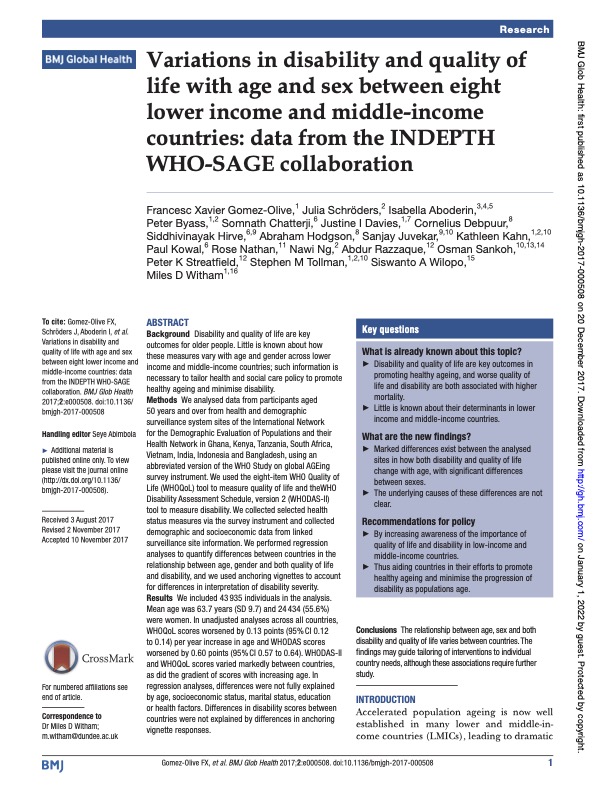
Francesc Xavier Gomez-Olive, Julia Schröders, Isabella Aboderin, Peter Byass, Somnath Chatterji, Justine I Davies, Cornelius Debpuur, Siddhivinayak Hirve, Abraham Hodgson, Sanjay Juvekar, Kathleen Kahn, Paul Kowal, Rose Nathan, Nawi Ng, Abdur Razzaque, Osman Sankoh, Peter K Streatfield, Stephen M Tollman, Siswanto A Wilopo, Miles D Witham
Variations in disability and quality of life with age and sex between eight lower income and middle-income countries: data from the INDEPTH WHO-SAGE collaboration
- JURNAL
Background
Disability and quality of life are key outcomes for older people. Little is known about how these measures vary with age and gender across lower income and middle-income countries; such information is necessary to tailor health and social care policy to promote healthy ageing and minimise disability.
Methods
We analysed data from participants aged 50 years and over from health and demographic surveillance system sites of the International Network for the Demographic Evaluation of Populations and their Health Network in Ghana, Kenya, Tanzania, South Africa, Vietnam, India, Indonesia and Bangladesh, using an abbreviated version of the WHO Study on global AGEing survey instrument. We used the eight-item WHO Quality of Life (WHOQoL) tool to measure quality of life and theWHO Disability Assessment Schedule, version 2 (WHODAS-II) tool to measure disability. We collected selected health status measures via the survey instrument and collected demographic and socioeconomic data from linked surveillance site information. We performed regression analyses to quantify differences between countries in the relationship between age, gender and both quality of life and disability, and we used anchoring vignettes to account for differences in interpretation of disability severity.
Results
We included 43 935 individuals in the analysis. Mean age was 63.7 years (SD 9.7) and 24 434 (55.6%) were women. In unadjusted analyses across all countries, WHOQoL scores worsened by 0.13 points (95% CI 0.12 to 0.14) per year increase in age and WHODAS scores worsened by 0.60 points (95% CI 0.57 to 0.64). WHODAS-II and WHOQoL scores varied markedly between countries, as did the gradient of scores with increasing age. In regression analyses, differences were not fully explained by age, socioeconomic status, marital status, education or health factors. Differences in disability scores between countries were not explained by differences in anchoring vignette responses.
Conclusions
The relationship between age, sex and both disability and quality of life varies between countries. The findings may guide tailoring of interventions to individual country needs, although these associations require further study.
Impact of Indonesia’s national health insurance scheme on inequality in access to maternal health services: A propensity score matched analysis
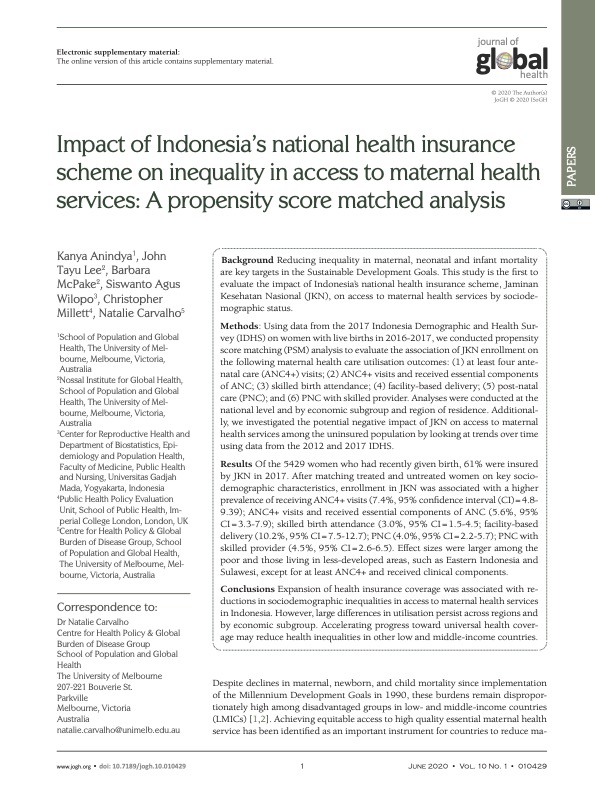
Kanya Anindya, John Tayu Lee, Barbara McPake, Siswanto Agus Wilopo, Christopher Millett, Natalie Carvalho
Impact of Indonesia’s national health insurance scheme on inequality in access to maternal health services: A propensity score matched analysis
- JURNAL
Background Reducing inequality in maternal, neonatal and infant mortality are key targets in the Sustainable Development Goals. This study is the first to evaluate the impact of Indonesia’s national health insurance scheme, Jaminan Kesehatan Nasional (JKN), on access to maternal health services by sociodemographic status. Methods: Using data from the 2017 Indonesia Demographic and Health Survey (IDHS) on women with live births in 2016-2017, we conducted propensity score matching (PSM) analysis to evaluate the association of JKN enrollment on the following maternal health care utilisation outcomes: (1) at least four antenatal care (ANC4+) visits; (2) ANC4+ visits and received essential components of ANC; (3) skilled birth attendance; (4) facility-based delivery; (5) post-natal care (PNC); and (6) PNC with skilled provider. Analyses were conducted at the national level and by economic subgroup and region of residence. Additionally, we investigated the potential negative impact of JKN on access to maternal health services among the uninsured population by looking at trends over time using data from the 2012 and 2017 IDHS. Results Of the 5429 women who had recently given birth, 61% were insured by JKN in 2017. After matching treated and untreated women on key sociodemographic characteristics, enrollment in JKN was associated with a higher prevalence of receiving ANC4+ visits (7.4%, 95% confidence interval (CI)=4.8- 9.39); ANC4+ visits and received essential components of ANC (5.6%, 95% CI=3.3-7.9); skilled birth attendance (3.0%, 95% CI=1.5-4.5; facility-based delivery (10.2%, 95% CI=7.5-12.7); PNC (4.0%, 95% CI=2.2-5.7); PNC with skilled provider (4.5%, 95% CI=2.6-6.5). Effect sizes were larger among the poor and those living in less-developed areas, such as Eastern Indonesia and Sulawesi, except for at least ANC4+ and received clinical components. Conclusions Expansion of health insurance coverage was associated with reductions in sociodemographic inequalities in access to maternal health services in Indonesia. However, large differences in utilisation persist across regions and by economic subgroup. Accelerating progress toward universal health coverage may reduce health inequalities in other low and middle-income countries.


